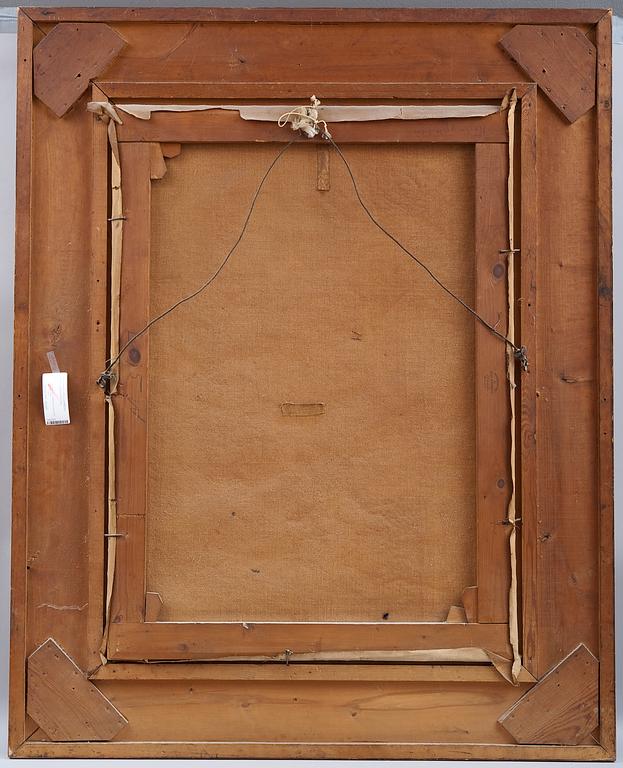Elin Danielson-Gambogi
A GIRL BY THE OVEN.
Sign. 1894. Oil on canvas 93x67 cm.
Provenance
Bought from the artist in Turku in 1894. Since then owned by the same family.
More information
Elin Danielson: , "A girl by the oven". 1894
”Jag trifs så bra här i hjertat af Savolax, folket är vänligt och rätt roligt. - - Här hos Kinnula på
Tolvaniemi ha vi trefligt logi och hyggligt bemötande. Eget hus här och en liten ganska behändig
piga.” (Elin Danielsons brev till Hilma Westerholm 11.8.1894)
”I feel so at home here in the heart of Savolax, the people are friendly and quite fun. - -Our reception here at Kinnula in Tolvaniemi has been pleasant and our lodgings are also nice. A house of our own and a small, rather clever maid.” (Letter from Elin Danielson to Hilma Westerholm, 11.8.1894)
Elin Danielson spent the summer of 1894 working in Savolax. First she stayed with her sister Rosa (known at Tytty) Ahonius in Pulsa, where Rosa's husband worked as station-master, before moving to Kinnula farm in Tolvanniemi near Savonlinna, in August. She had fallen in love with the landscapes and the people of the area. The big oil painting depicting a young peasant girl sitting by the fire is one of the works Elin Danielson worked on during this Savolax summer, the subject of which can be traced directly back to the rural surroundings. The exact location depicted in the painting is unknown but it's quite possibly Kinnula, and who knows if the girl isn't the same ”small, clever maid” that Danielson mentions in her letter. The interior and the props, such as the gold-edged cup the girl is holding, are not so much a reference to life in the countryside as it echoes Danielson's own life as a summer resident in a temporary, rented house.
The artist's colony that had sprung up in Önningeby on Åland, where Elin Danielson had previously spent many of her summers, had started to feel too small for her. The nationalistic and Carelianistic flame that had been kindled among the artistic circles in the 1890s came to influence Danielson as well, mainly through her two artist friends Pekka Halonen and Axel Gallén (later Axel Gallen-Kallela). It formed part of the reason for her departure from Åland, and she undertook her first trip to eastern Finland, to Ruskeala and Kitee, in the spring of 1892 in the company of Pekka Halonen. Though Elin Danielson never became a full-fledged carelianist, she was for many years nevertheless interested in the idea of a return to the roots of Finnishness, and painted in Tarttila, Sääksmäki as late as the summer of 1895. She then moved to Italy, where she settled down permanently through her marriage with Italian artist Raffaello Gambogi.
Elin Danielson's painting of the delicate peasant girl was sold to a private buyer soon after its completion, and is interesting and quite rare in the sense that is has never been exhibited. It's also a significant discovery in that Elin Danielson's folk motifs remain relatively unknown. It appears that she may have kept Axel Gallén's earlier work of similar subjects in mind as she was painting. For example the use of firelight is found in many of Gallén's earlier works as an important atmospherical element, lending the pictures their mood.
Designer
Elin Danielson-Gambogi was a Finnish-Swedish artist born in Norrmark, Finnland. She studied at the Finnish Art Society's Drawing School in Helsinki, under Carl Eneas Sjöström, Hjalmar Munsterhjelm, in Adolf von Beckers private art school and in Paris as Académie Colarossi, and with Auguste Rodin. Danielson-Gambogi had been taught the art of classic drawing, landscape painting, perspective painting, porcelain painting, and was even for a period active in the porcelain factory Arabia. She was part of the so-called Önningeby colony, whose members consisted of Victor Westerholm, Fredrik Ahlstedt, J.A.G Acke and Nina Ahlstedt. Daniel-Gambogi was controversial, her portraits of women glurred boundaries as they showed every day, lightly dressed women. Her art is derivative of naturalism and national romanticism, and she favours a light colour pallet to depict the Mediterranean in a manner which calls upon impressionistic and academic painting styles.
Read more






































